Effective Policing Strategies for Crime Prevention in Washington DC
VerifiedAdded on 2021/06/17
|12
|3173
|36
Report
AI Summary
This report provides an in-depth analysis of various policing strategies, focusing on their application in Washington DC to address crime and disorder, particularly concerning drug and alcohol abuse. The paper examines three key approaches: third-party policing, hot spot policing, and community policing. Third-party policing involves leveraging individuals or groups responsible for crime control to take responsibility for local crime issues, with a focus on targeting establishments contributing to substance abuse. Hot spot policing is explored as a method of directing resources to areas with high crime concentrations, utilizing crime mapping technology to identify and address specific locations. Finally, the report discusses community policing as a philosophy that involves the community in crime prevention efforts, emphasizing organizational transformation, community partnerships, and problem-solving approaches. The report highlights the potential benefits and challenges of each strategy, offering insights into their effectiveness in the context of the District of Columbia.

Running head: INTRODUCTION TO POLICING STRATEGIES
Introduction to Policing Strategies
Name
Institution
Date
Introduction to Policing Strategies
Name
Institution
Date
Paraphrase This Document
Need a fresh take? Get an instant paraphrase of this document with our AI Paraphraser
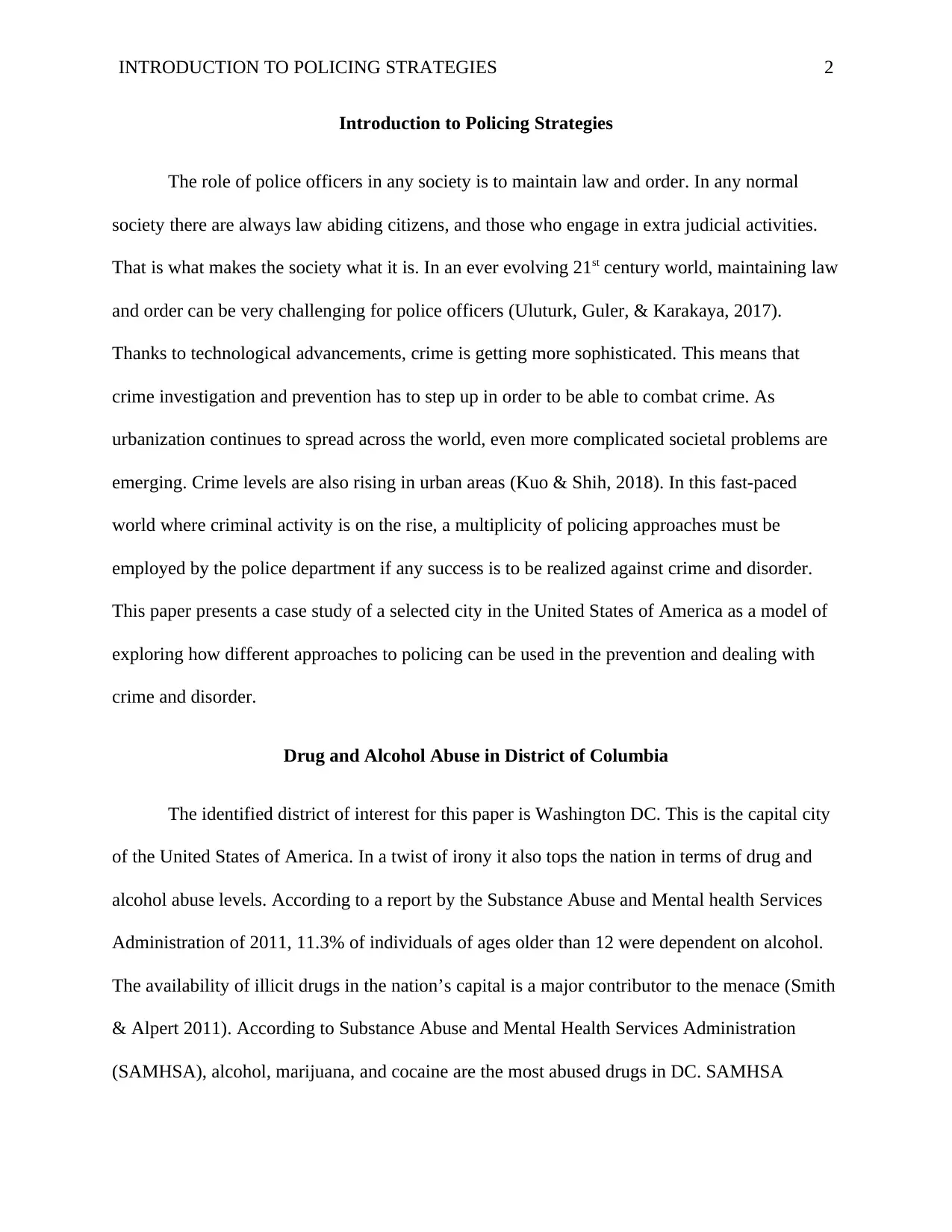
INTRODUCTION TO POLICING STRATEGIES 2
Introduction to Policing Strategies
The role of police officers in any society is to maintain law and order. In any normal
society there are always law abiding citizens, and those who engage in extra judicial activities.
That is what makes the society what it is. In an ever evolving 21st century world, maintaining law
and order can be very challenging for police officers (Uluturk, Guler, & Karakaya, 2017).
Thanks to technological advancements, crime is getting more sophisticated. This means that
crime investigation and prevention has to step up in order to be able to combat crime. As
urbanization continues to spread across the world, even more complicated societal problems are
emerging. Crime levels are also rising in urban areas (Kuo & Shih, 2018). In this fast-paced
world where criminal activity is on the rise, a multiplicity of policing approaches must be
employed by the police department if any success is to be realized against crime and disorder.
This paper presents a case study of a selected city in the United States of America as a model of
exploring how different approaches to policing can be used in the prevention and dealing with
crime and disorder.
Drug and Alcohol Abuse in District of Columbia
The identified district of interest for this paper is Washington DC. This is the capital city
of the United States of America. In a twist of irony it also tops the nation in terms of drug and
alcohol abuse levels. According to a report by the Substance Abuse and Mental health Services
Administration of 2011, 11.3% of individuals of ages older than 12 were dependent on alcohol.
The availability of illicit drugs in the nation’s capital is a major contributor to the menace (Smith
& Alpert 2011). According to Substance Abuse and Mental Health Services Administration
(SAMHSA), alcohol, marijuana, and cocaine are the most abused drugs in DC. SAMHSA
Introduction to Policing Strategies
The role of police officers in any society is to maintain law and order. In any normal
society there are always law abiding citizens, and those who engage in extra judicial activities.
That is what makes the society what it is. In an ever evolving 21st century world, maintaining law
and order can be very challenging for police officers (Uluturk, Guler, & Karakaya, 2017).
Thanks to technological advancements, crime is getting more sophisticated. This means that
crime investigation and prevention has to step up in order to be able to combat crime. As
urbanization continues to spread across the world, even more complicated societal problems are
emerging. Crime levels are also rising in urban areas (Kuo & Shih, 2018). In this fast-paced
world where criminal activity is on the rise, a multiplicity of policing approaches must be
employed by the police department if any success is to be realized against crime and disorder.
This paper presents a case study of a selected city in the United States of America as a model of
exploring how different approaches to policing can be used in the prevention and dealing with
crime and disorder.
Drug and Alcohol Abuse in District of Columbia
The identified district of interest for this paper is Washington DC. This is the capital city
of the United States of America. In a twist of irony it also tops the nation in terms of drug and
alcohol abuse levels. According to a report by the Substance Abuse and Mental health Services
Administration of 2011, 11.3% of individuals of ages older than 12 were dependent on alcohol.
The availability of illicit drugs in the nation’s capital is a major contributor to the menace (Smith
& Alpert 2011). According to Substance Abuse and Mental Health Services Administration
(SAMHSA), alcohol, marijuana, and cocaine are the most abused drugs in DC. SAMHSA
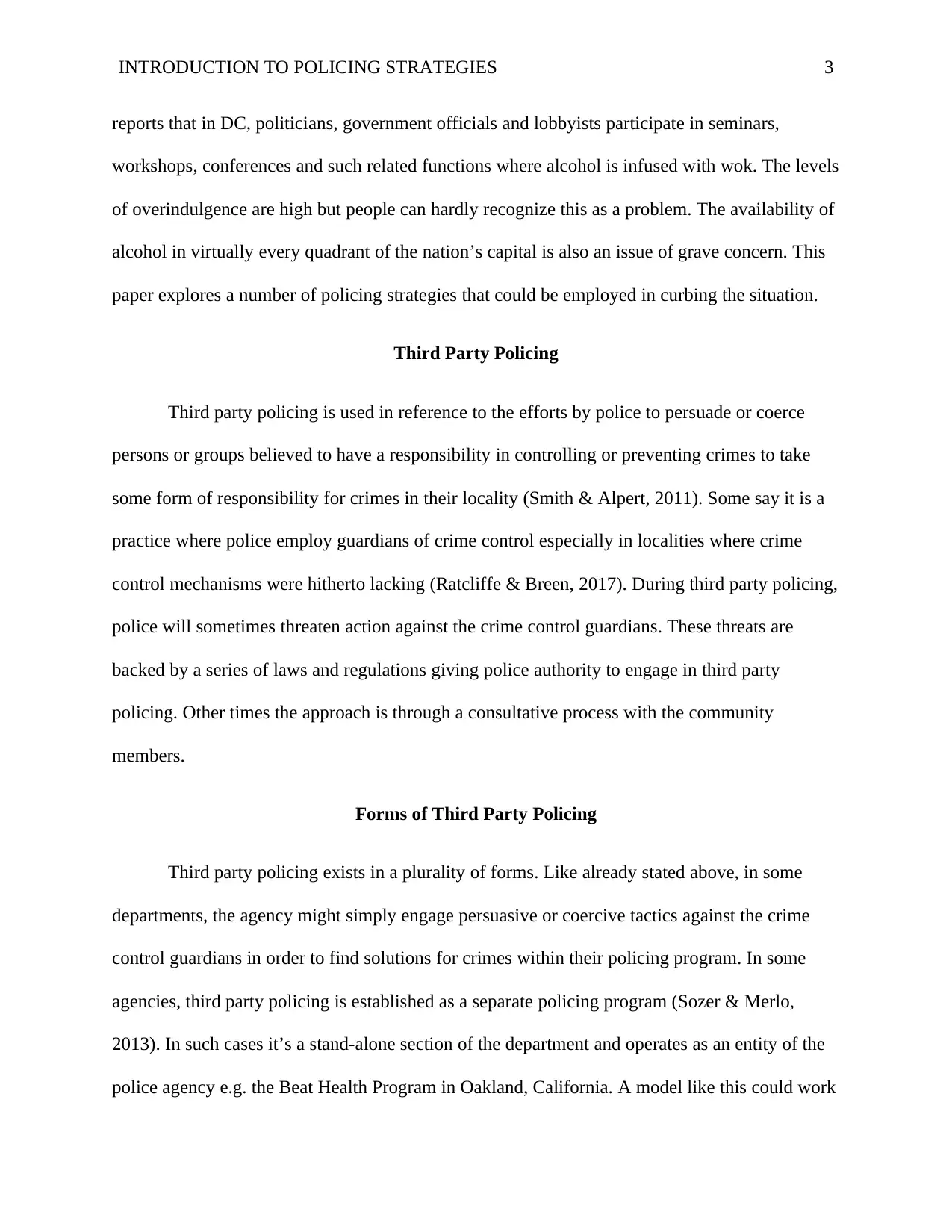
INTRODUCTION TO POLICING STRATEGIES 3
reports that in DC, politicians, government officials and lobbyists participate in seminars,
workshops, conferences and such related functions where alcohol is infused with wok. The levels
of overindulgence are high but people can hardly recognize this as a problem. The availability of
alcohol in virtually every quadrant of the nation’s capital is also an issue of grave concern. This
paper explores a number of policing strategies that could be employed in curbing the situation.
Third Party Policing
Third party policing is used in reference to the efforts by police to persuade or coerce
persons or groups believed to have a responsibility in controlling or preventing crimes to take
some form of responsibility for crimes in their locality (Smith & Alpert, 2011). Some say it is a
practice where police employ guardians of crime control especially in localities where crime
control mechanisms were hitherto lacking (Ratcliffe & Breen, 2017). During third party policing,
police will sometimes threaten action against the crime control guardians. These threats are
backed by a series of laws and regulations giving police authority to engage in third party
policing. Other times the approach is through a consultative process with the community
members.
Forms of Third Party Policing
Third party policing exists in a plurality of forms. Like already stated above, in some
departments, the agency might simply engage persuasive or coercive tactics against the crime
control guardians in order to find solutions for crimes within their policing program. In some
agencies, third party policing is established as a separate policing program (Sozer & Merlo,
2013). In such cases it’s a stand-alone section of the department and operates as an entity of the
police agency e.g. the Beat Health Program in Oakland, California. A model like this could work
reports that in DC, politicians, government officials and lobbyists participate in seminars,
workshops, conferences and such related functions where alcohol is infused with wok. The levels
of overindulgence are high but people can hardly recognize this as a problem. The availability of
alcohol in virtually every quadrant of the nation’s capital is also an issue of grave concern. This
paper explores a number of policing strategies that could be employed in curbing the situation.
Third Party Policing
Third party policing is used in reference to the efforts by police to persuade or coerce
persons or groups believed to have a responsibility in controlling or preventing crimes to take
some form of responsibility for crimes in their locality (Smith & Alpert, 2011). Some say it is a
practice where police employ guardians of crime control especially in localities where crime
control mechanisms were hitherto lacking (Ratcliffe & Breen, 2017). During third party policing,
police will sometimes threaten action against the crime control guardians. These threats are
backed by a series of laws and regulations giving police authority to engage in third party
policing. Other times the approach is through a consultative process with the community
members.
Forms of Third Party Policing
Third party policing exists in a plurality of forms. Like already stated above, in some
departments, the agency might simply engage persuasive or coercive tactics against the crime
control guardians in order to find solutions for crimes within their policing program. In some
agencies, third party policing is established as a separate policing program (Sozer & Merlo,
2013). In such cases it’s a stand-alone section of the department and operates as an entity of the
police agency e.g. the Beat Health Program in Oakland, California. A model like this could work
⊘ This is a preview!⊘
Do you want full access?
Subscribe today to unlock all pages.

Trusted by 1+ million students worldwide
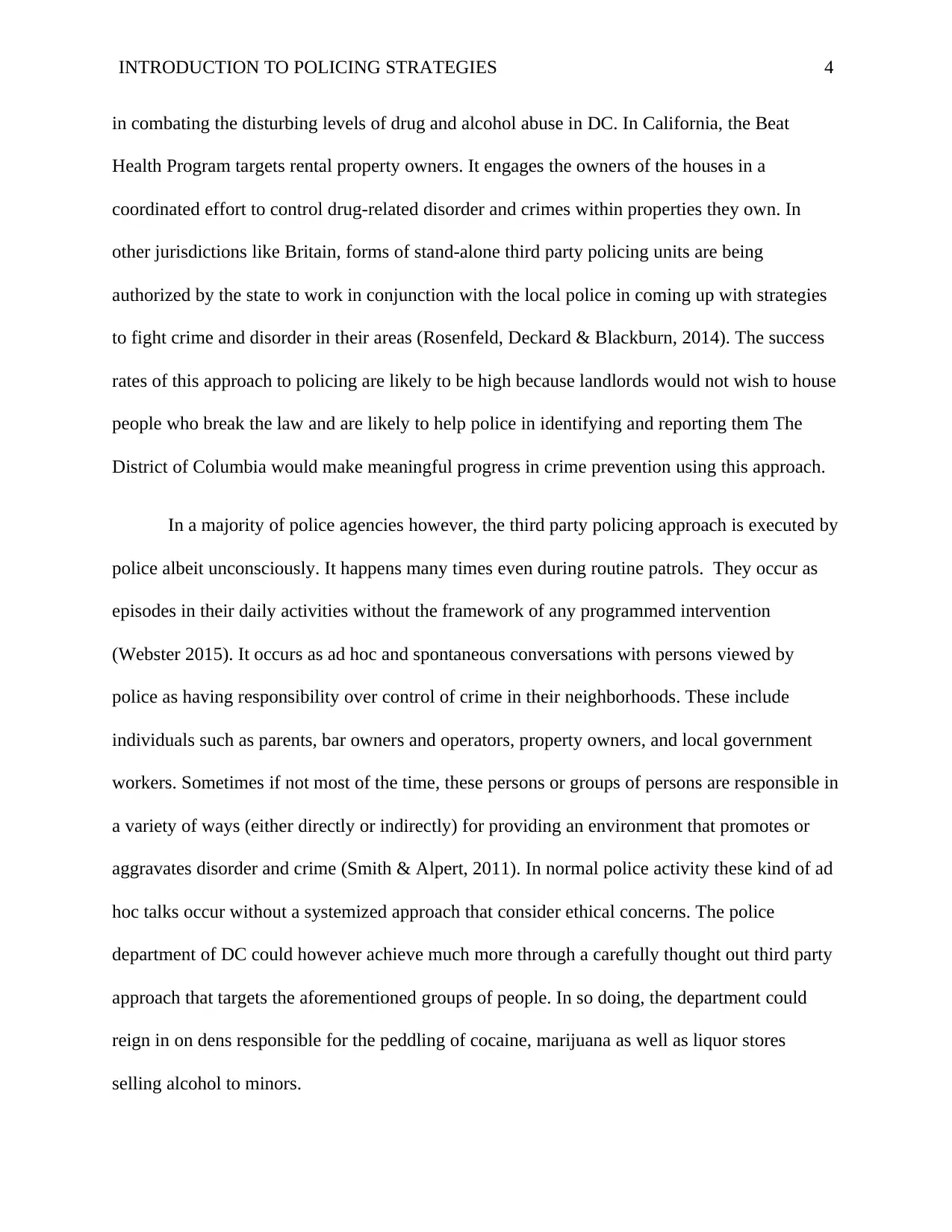
INTRODUCTION TO POLICING STRATEGIES 4
in combating the disturbing levels of drug and alcohol abuse in DC. In California, the Beat
Health Program targets rental property owners. It engages the owners of the houses in a
coordinated effort to control drug-related disorder and crimes within properties they own. In
other jurisdictions like Britain, forms of stand-alone third party policing units are being
authorized by the state to work in conjunction with the local police in coming up with strategies
to fight crime and disorder in their areas (Rosenfeld, Deckard & Blackburn, 2014). The success
rates of this approach to policing are likely to be high because landlords would not wish to house
people who break the law and are likely to help police in identifying and reporting them The
District of Columbia would make meaningful progress in crime prevention using this approach.
In a majority of police agencies however, the third party policing approach is executed by
police albeit unconsciously. It happens many times even during routine patrols. They occur as
episodes in their daily activities without the framework of any programmed intervention
(Webster 2015). It occurs as ad hoc and spontaneous conversations with persons viewed by
police as having responsibility over control of crime in their neighborhoods. These include
individuals such as parents, bar owners and operators, property owners, and local government
workers. Sometimes if not most of the time, these persons or groups of persons are responsible in
a variety of ways (either directly or indirectly) for providing an environment that promotes or
aggravates disorder and crime (Smith & Alpert, 2011). In normal police activity these kind of ad
hoc talks occur without a systemized approach that consider ethical concerns. The police
department of DC could however achieve much more through a carefully thought out third party
approach that targets the aforementioned groups of people. In so doing, the department could
reign in on dens responsible for the peddling of cocaine, marijuana as well as liquor stores
selling alcohol to minors.
in combating the disturbing levels of drug and alcohol abuse in DC. In California, the Beat
Health Program targets rental property owners. It engages the owners of the houses in a
coordinated effort to control drug-related disorder and crimes within properties they own. In
other jurisdictions like Britain, forms of stand-alone third party policing units are being
authorized by the state to work in conjunction with the local police in coming up with strategies
to fight crime and disorder in their areas (Rosenfeld, Deckard & Blackburn, 2014). The success
rates of this approach to policing are likely to be high because landlords would not wish to house
people who break the law and are likely to help police in identifying and reporting them The
District of Columbia would make meaningful progress in crime prevention using this approach.
In a majority of police agencies however, the third party policing approach is executed by
police albeit unconsciously. It happens many times even during routine patrols. They occur as
episodes in their daily activities without the framework of any programmed intervention
(Webster 2015). It occurs as ad hoc and spontaneous conversations with persons viewed by
police as having responsibility over control of crime in their neighborhoods. These include
individuals such as parents, bar owners and operators, property owners, and local government
workers. Sometimes if not most of the time, these persons or groups of persons are responsible in
a variety of ways (either directly or indirectly) for providing an environment that promotes or
aggravates disorder and crime (Smith & Alpert, 2011). In normal police activity these kind of ad
hoc talks occur without a systemized approach that consider ethical concerns. The police
department of DC could however achieve much more through a carefully thought out third party
approach that targets the aforementioned groups of people. In so doing, the department could
reign in on dens responsible for the peddling of cocaine, marijuana as well as liquor stores
selling alcohol to minors.
Paraphrase This Document
Need a fresh take? Get an instant paraphrase of this document with our AI Paraphraser
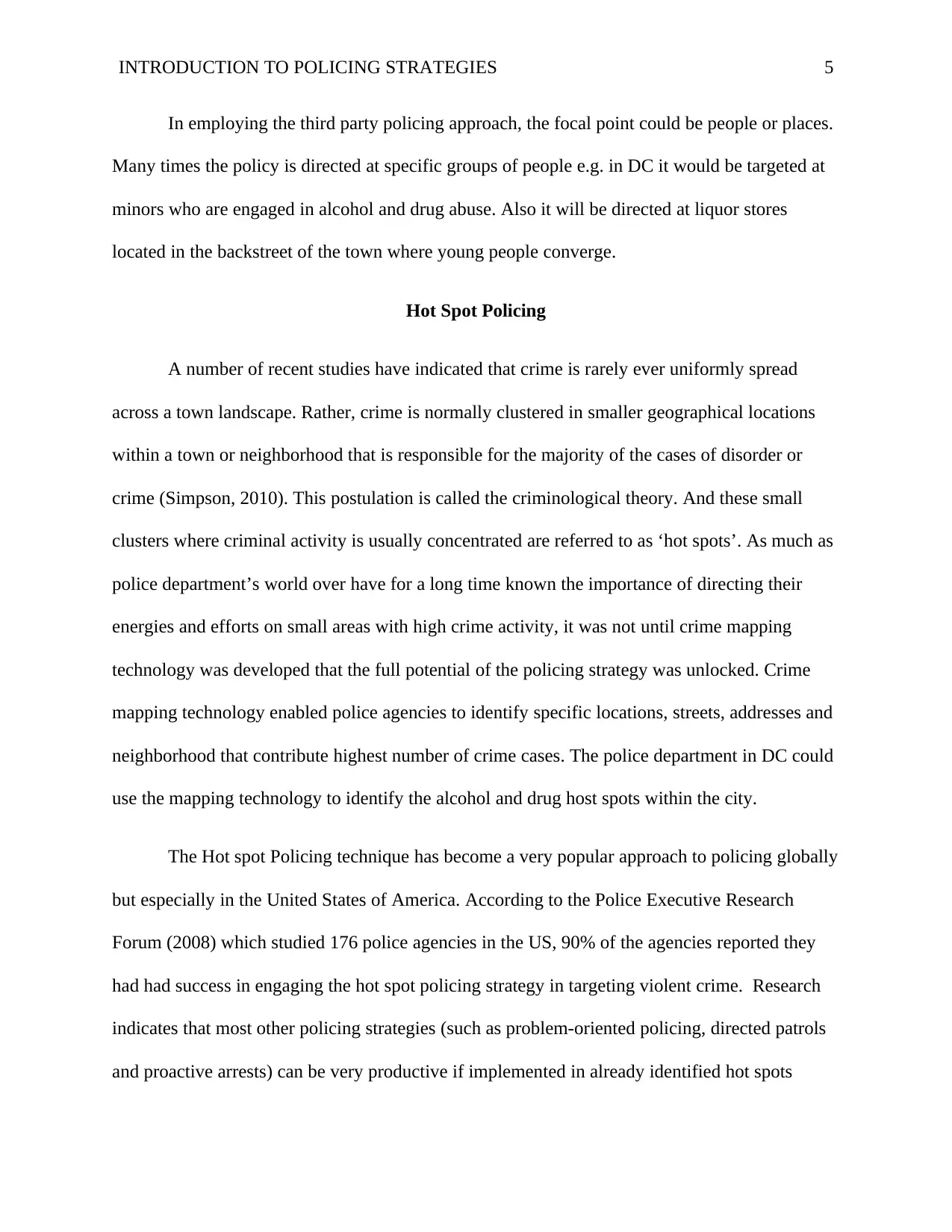
INTRODUCTION TO POLICING STRATEGIES 5
In employing the third party policing approach, the focal point could be people or places.
Many times the policy is directed at specific groups of people e.g. in DC it would be targeted at
minors who are engaged in alcohol and drug abuse. Also it will be directed at liquor stores
located in the backstreet of the town where young people converge.
Hot Spot Policing
A number of recent studies have indicated that crime is rarely ever uniformly spread
across a town landscape. Rather, crime is normally clustered in smaller geographical locations
within a town or neighborhood that is responsible for the majority of the cases of disorder or
crime (Simpson, 2010). This postulation is called the criminological theory. And these small
clusters where criminal activity is usually concentrated are referred to as ‘hot spots’. As much as
police department’s world over have for a long time known the importance of directing their
energies and efforts on small areas with high crime activity, it was not until crime mapping
technology was developed that the full potential of the policing strategy was unlocked. Crime
mapping technology enabled police agencies to identify specific locations, streets, addresses and
neighborhood that contribute highest number of crime cases. The police department in DC could
use the mapping technology to identify the alcohol and drug host spots within the city.
The Hot spot Policing technique has become a very popular approach to policing globally
but especially in the United States of America. According to the Police Executive Research
Forum (2008) which studied 176 police agencies in the US, 90% of the agencies reported they
had had success in engaging the hot spot policing strategy in targeting violent crime. Research
indicates that most other policing strategies (such as problem-oriented policing, directed patrols
and proactive arrests) can be very productive if implemented in already identified hot spots
In employing the third party policing approach, the focal point could be people or places.
Many times the policy is directed at specific groups of people e.g. in DC it would be targeted at
minors who are engaged in alcohol and drug abuse. Also it will be directed at liquor stores
located in the backstreet of the town where young people converge.
Hot Spot Policing
A number of recent studies have indicated that crime is rarely ever uniformly spread
across a town landscape. Rather, crime is normally clustered in smaller geographical locations
within a town or neighborhood that is responsible for the majority of the cases of disorder or
crime (Simpson, 2010). This postulation is called the criminological theory. And these small
clusters where criminal activity is usually concentrated are referred to as ‘hot spots’. As much as
police department’s world over have for a long time known the importance of directing their
energies and efforts on small areas with high crime activity, it was not until crime mapping
technology was developed that the full potential of the policing strategy was unlocked. Crime
mapping technology enabled police agencies to identify specific locations, streets, addresses and
neighborhood that contribute highest number of crime cases. The police department in DC could
use the mapping technology to identify the alcohol and drug host spots within the city.
The Hot spot Policing technique has become a very popular approach to policing globally
but especially in the United States of America. According to the Police Executive Research
Forum (2008) which studied 176 police agencies in the US, 90% of the agencies reported they
had had success in engaging the hot spot policing strategy in targeting violent crime. Research
indicates that most other policing strategies (such as problem-oriented policing, directed patrols
and proactive arrests) can be very productive if implemented in already identified hot spots
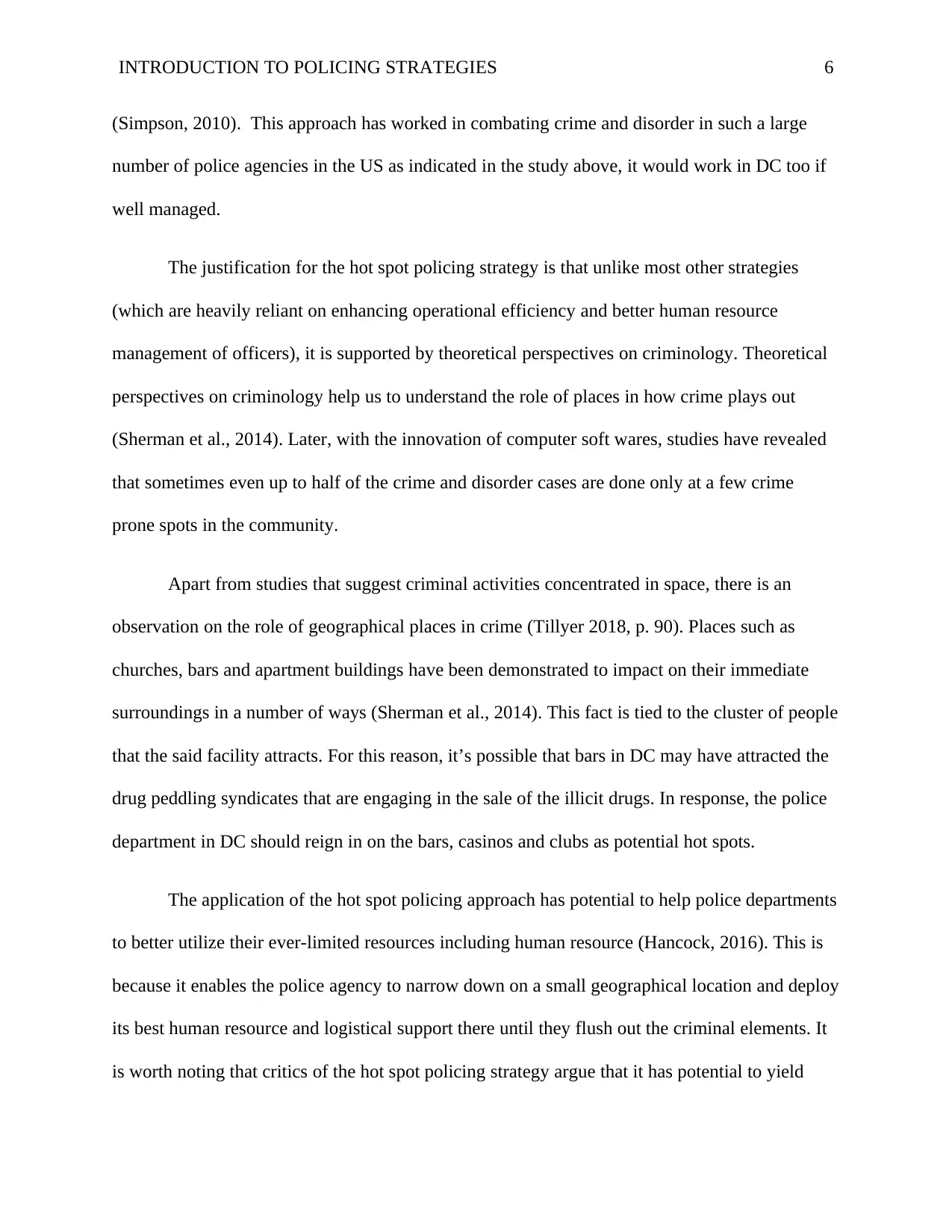
INTRODUCTION TO POLICING STRATEGIES 6
(Simpson, 2010). This approach has worked in combating crime and disorder in such a large
number of police agencies in the US as indicated in the study above, it would work in DC too if
well managed.
The justification for the hot spot policing strategy is that unlike most other strategies
(which are heavily reliant on enhancing operational efficiency and better human resource
management of officers), it is supported by theoretical perspectives on criminology. Theoretical
perspectives on criminology help us to understand the role of places in how crime plays out
(Sherman et al., 2014). Later, with the innovation of computer soft wares, studies have revealed
that sometimes even up to half of the crime and disorder cases are done only at a few crime
prone spots in the community.
Apart from studies that suggest criminal activities concentrated in space, there is an
observation on the role of geographical places in crime (Tillyer 2018, p. 90). Places such as
churches, bars and apartment buildings have been demonstrated to impact on their immediate
surroundings in a number of ways (Sherman et al., 2014). This fact is tied to the cluster of people
that the said facility attracts. For this reason, it’s possible that bars in DC may have attracted the
drug peddling syndicates that are engaging in the sale of the illicit drugs. In response, the police
department in DC should reign in on the bars, casinos and clubs as potential hot spots.
The application of the hot spot policing approach has potential to help police departments
to better utilize their ever-limited resources including human resource (Hancock, 2016). This is
because it enables the police agency to narrow down on a small geographical location and deploy
its best human resource and logistical support there until they flush out the criminal elements. It
is worth noting that critics of the hot spot policing strategy argue that it has potential to yield
(Simpson, 2010). This approach has worked in combating crime and disorder in such a large
number of police agencies in the US as indicated in the study above, it would work in DC too if
well managed.
The justification for the hot spot policing strategy is that unlike most other strategies
(which are heavily reliant on enhancing operational efficiency and better human resource
management of officers), it is supported by theoretical perspectives on criminology. Theoretical
perspectives on criminology help us to understand the role of places in how crime plays out
(Sherman et al., 2014). Later, with the innovation of computer soft wares, studies have revealed
that sometimes even up to half of the crime and disorder cases are done only at a few crime
prone spots in the community.
Apart from studies that suggest criminal activities concentrated in space, there is an
observation on the role of geographical places in crime (Tillyer 2018, p. 90). Places such as
churches, bars and apartment buildings have been demonstrated to impact on their immediate
surroundings in a number of ways (Sherman et al., 2014). This fact is tied to the cluster of people
that the said facility attracts. For this reason, it’s possible that bars in DC may have attracted the
drug peddling syndicates that are engaging in the sale of the illicit drugs. In response, the police
department in DC should reign in on the bars, casinos and clubs as potential hot spots.
The application of the hot spot policing approach has potential to help police departments
to better utilize their ever-limited resources including human resource (Hancock, 2016). This is
because it enables the police agency to narrow down on a small geographical location and deploy
its best human resource and logistical support there until they flush out the criminal elements. It
is worth noting that critics of the hot spot policing strategy argue that it has potential to yield
⊘ This is a preview!⊘
Do you want full access?
Subscribe today to unlock all pages.

Trusted by 1+ million students worldwide
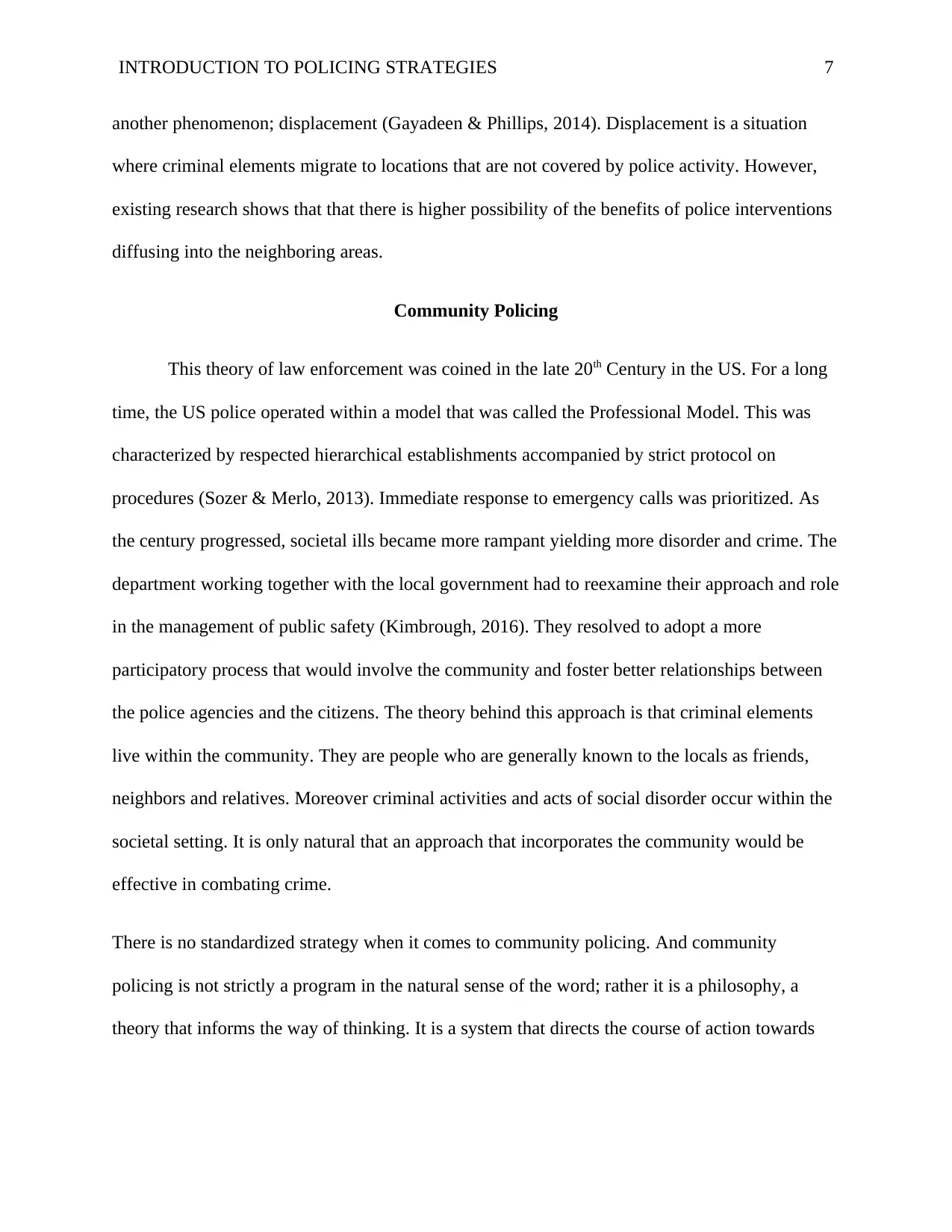
INTRODUCTION TO POLICING STRATEGIES 7
another phenomenon; displacement (Gayadeen & Phillips, 2014). Displacement is a situation
where criminal elements migrate to locations that are not covered by police activity. However,
existing research shows that that there is higher possibility of the benefits of police interventions
diffusing into the neighboring areas.
Community Policing
This theory of law enforcement was coined in the late 20th Century in the US. For a long
time, the US police operated within a model that was called the Professional Model. This was
characterized by respected hierarchical establishments accompanied by strict protocol on
procedures (Sozer & Merlo, 2013). Immediate response to emergency calls was prioritized. As
the century progressed, societal ills became more rampant yielding more disorder and crime. The
department working together with the local government had to reexamine their approach and role
in the management of public safety (Kimbrough, 2016). They resolved to adopt a more
participatory process that would involve the community and foster better relationships between
the police agencies and the citizens. The theory behind this approach is that criminal elements
live within the community. They are people who are generally known to the locals as friends,
neighbors and relatives. Moreover criminal activities and acts of social disorder occur within the
societal setting. It is only natural that an approach that incorporates the community would be
effective in combating crime.
There is no standardized strategy when it comes to community policing. And community
policing is not strictly a program in the natural sense of the word; rather it is a philosophy, a
theory that informs the way of thinking. It is a system that directs the course of action towards
another phenomenon; displacement (Gayadeen & Phillips, 2014). Displacement is a situation
where criminal elements migrate to locations that are not covered by police activity. However,
existing research shows that that there is higher possibility of the benefits of police interventions
diffusing into the neighboring areas.
Community Policing
This theory of law enforcement was coined in the late 20th Century in the US. For a long
time, the US police operated within a model that was called the Professional Model. This was
characterized by respected hierarchical establishments accompanied by strict protocol on
procedures (Sozer & Merlo, 2013). Immediate response to emergency calls was prioritized. As
the century progressed, societal ills became more rampant yielding more disorder and crime. The
department working together with the local government had to reexamine their approach and role
in the management of public safety (Kimbrough, 2016). They resolved to adopt a more
participatory process that would involve the community and foster better relationships between
the police agencies and the citizens. The theory behind this approach is that criminal elements
live within the community. They are people who are generally known to the locals as friends,
neighbors and relatives. Moreover criminal activities and acts of social disorder occur within the
societal setting. It is only natural that an approach that incorporates the community would be
effective in combating crime.
There is no standardized strategy when it comes to community policing. And community
policing is not strictly a program in the natural sense of the word; rather it is a philosophy, a
theory that informs the way of thinking. It is a system that directs the course of action towards
Paraphrase This Document
Need a fresh take? Get an instant paraphrase of this document with our AI Paraphraser
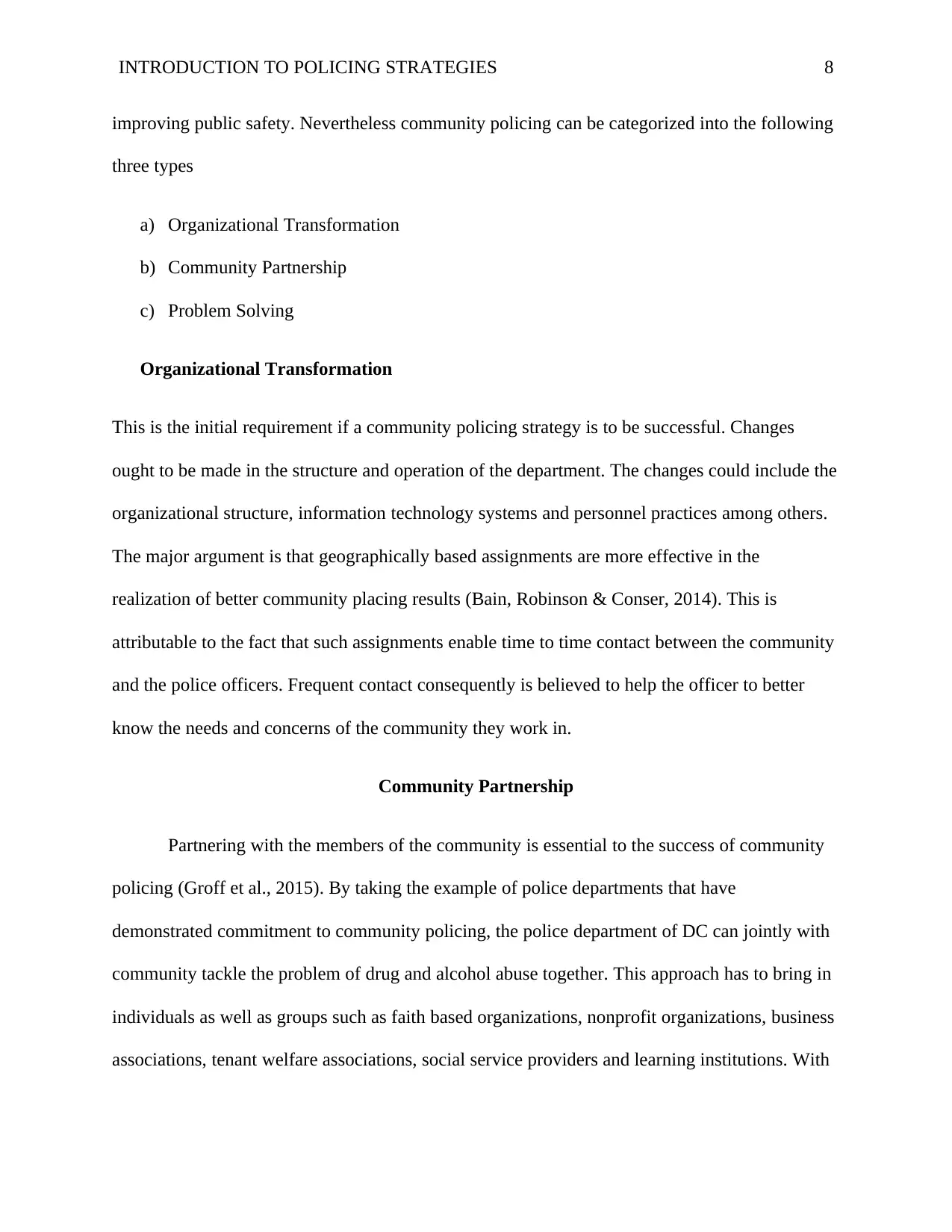
INTRODUCTION TO POLICING STRATEGIES 8
improving public safety. Nevertheless community policing can be categorized into the following
three types
a) Organizational Transformation
b) Community Partnership
c) Problem Solving
Organizational Transformation
This is the initial requirement if a community policing strategy is to be successful. Changes
ought to be made in the structure and operation of the department. The changes could include the
organizational structure, information technology systems and personnel practices among others.
The major argument is that geographically based assignments are more effective in the
realization of better community placing results (Bain, Robinson & Conser, 2014). This is
attributable to the fact that such assignments enable time to time contact between the community
and the police officers. Frequent contact consequently is believed to help the officer to better
know the needs and concerns of the community they work in.
Community Partnership
Partnering with the members of the community is essential to the success of community
policing (Groff et al., 2015). By taking the example of police departments that have
demonstrated commitment to community policing, the police department of DC can jointly with
community tackle the problem of drug and alcohol abuse together. This approach has to bring in
individuals as well as groups such as faith based organizations, nonprofit organizations, business
associations, tenant welfare associations, social service providers and learning institutions. With
improving public safety. Nevertheless community policing can be categorized into the following
three types
a) Organizational Transformation
b) Community Partnership
c) Problem Solving
Organizational Transformation
This is the initial requirement if a community policing strategy is to be successful. Changes
ought to be made in the structure and operation of the department. The changes could include the
organizational structure, information technology systems and personnel practices among others.
The major argument is that geographically based assignments are more effective in the
realization of better community placing results (Bain, Robinson & Conser, 2014). This is
attributable to the fact that such assignments enable time to time contact between the community
and the police officers. Frequent contact consequently is believed to help the officer to better
know the needs and concerns of the community they work in.
Community Partnership
Partnering with the members of the community is essential to the success of community
policing (Groff et al., 2015). By taking the example of police departments that have
demonstrated commitment to community policing, the police department of DC can jointly with
community tackle the problem of drug and alcohol abuse together. This approach has to bring in
individuals as well as groups such as faith based organizations, nonprofit organizations, business
associations, tenant welfare associations, social service providers and learning institutions. With
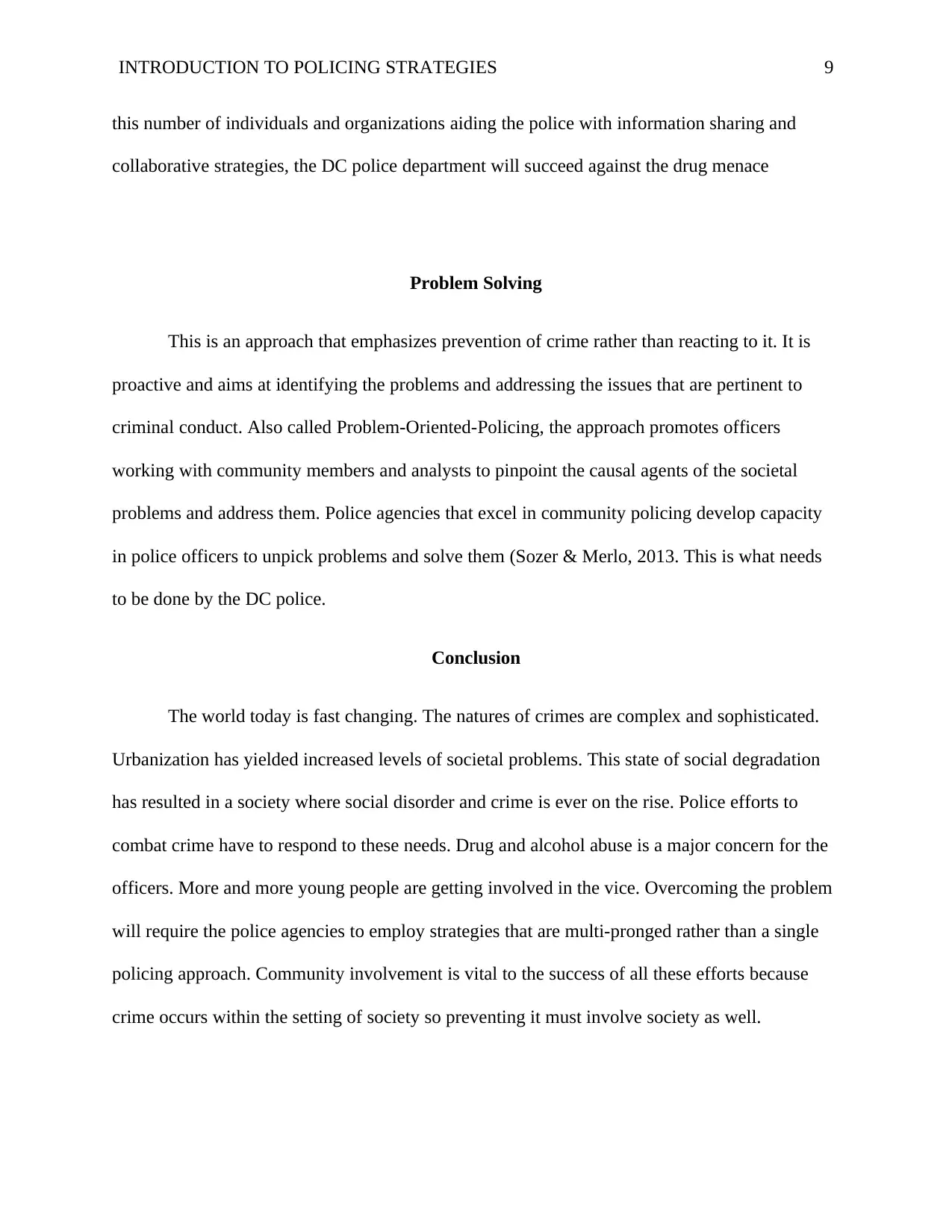
INTRODUCTION TO POLICING STRATEGIES 9
this number of individuals and organizations aiding the police with information sharing and
collaborative strategies, the DC police department will succeed against the drug menace
Problem Solving
This is an approach that emphasizes prevention of crime rather than reacting to it. It is
proactive and aims at identifying the problems and addressing the issues that are pertinent to
criminal conduct. Also called Problem-Oriented-Policing, the approach promotes officers
working with community members and analysts to pinpoint the causal agents of the societal
problems and address them. Police agencies that excel in community policing develop capacity
in police officers to unpick problems and solve them (Sozer & Merlo, 2013. This is what needs
to be done by the DC police.
Conclusion
The world today is fast changing. The natures of crimes are complex and sophisticated.
Urbanization has yielded increased levels of societal problems. This state of social degradation
has resulted in a society where social disorder and crime is ever on the rise. Police efforts to
combat crime have to respond to these needs. Drug and alcohol abuse is a major concern for the
officers. More and more young people are getting involved in the vice. Overcoming the problem
will require the police agencies to employ strategies that are multi-pronged rather than a single
policing approach. Community involvement is vital to the success of all these efforts because
crime occurs within the setting of society so preventing it must involve society as well.
this number of individuals and organizations aiding the police with information sharing and
collaborative strategies, the DC police department will succeed against the drug menace
Problem Solving
This is an approach that emphasizes prevention of crime rather than reacting to it. It is
proactive and aims at identifying the problems and addressing the issues that are pertinent to
criminal conduct. Also called Problem-Oriented-Policing, the approach promotes officers
working with community members and analysts to pinpoint the causal agents of the societal
problems and address them. Police agencies that excel in community policing develop capacity
in police officers to unpick problems and solve them (Sozer & Merlo, 2013. This is what needs
to be done by the DC police.
Conclusion
The world today is fast changing. The natures of crimes are complex and sophisticated.
Urbanization has yielded increased levels of societal problems. This state of social degradation
has resulted in a society where social disorder and crime is ever on the rise. Police efforts to
combat crime have to respond to these needs. Drug and alcohol abuse is a major concern for the
officers. More and more young people are getting involved in the vice. Overcoming the problem
will require the police agencies to employ strategies that are multi-pronged rather than a single
policing approach. Community involvement is vital to the success of all these efforts because
crime occurs within the setting of society so preventing it must involve society as well.
⊘ This is a preview!⊘
Do you want full access?
Subscribe today to unlock all pages.

Trusted by 1+ million students worldwide
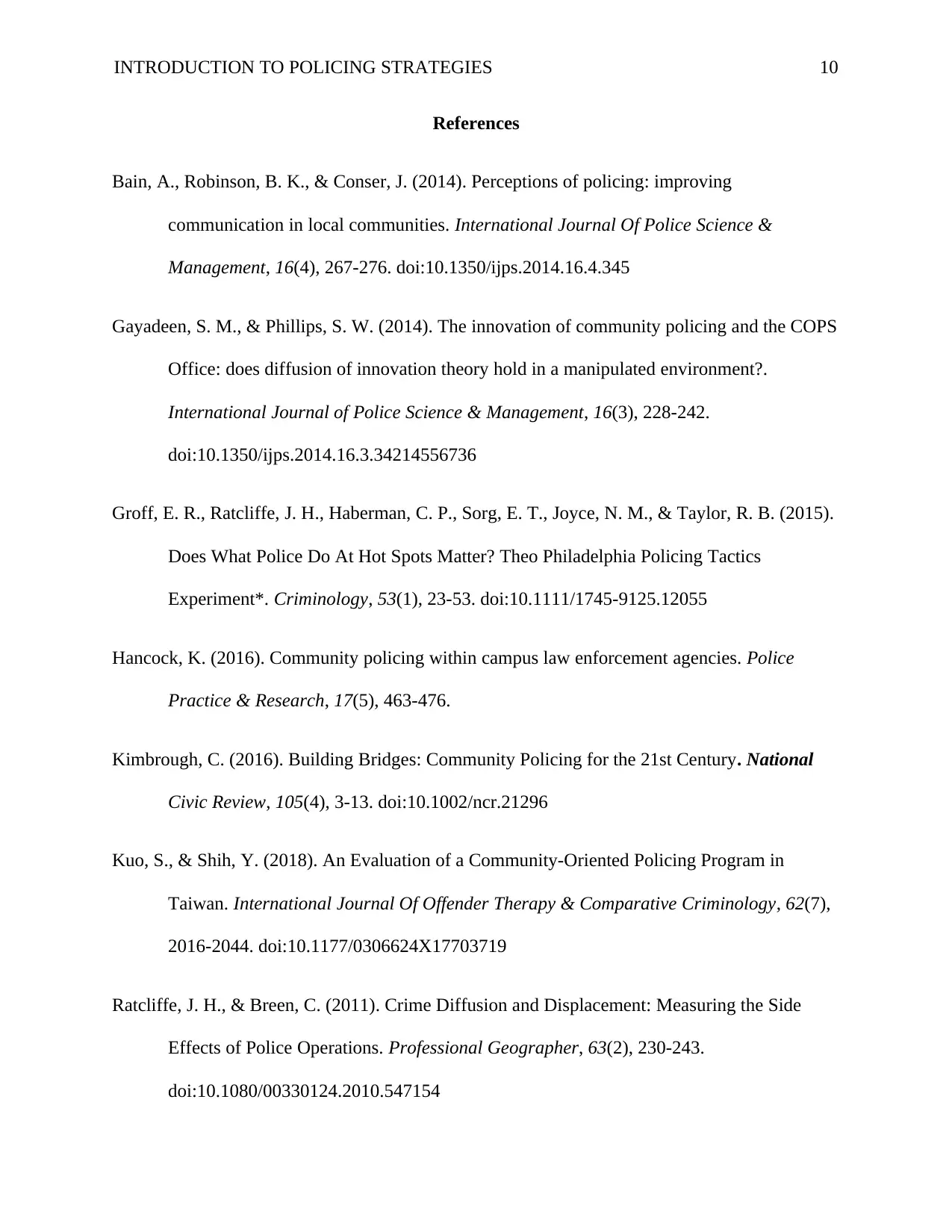
INTRODUCTION TO POLICING STRATEGIES 10
References
Bain, A., Robinson, B. K., & Conser, J. (2014). Perceptions of policing: improving
communication in local communities. International Journal Of Police Science &
Management, 16(4), 267-276. doi:10.1350/ijps.2014.16.4.345
Gayadeen, S. M., & Phillips, S. W. (2014). The innovation of community policing and the COPS
Office: does diffusion of innovation theory hold in a manipulated environment?.
International Journal of Police Science & Management, 16(3), 228-242.
doi:10.1350/ijps.2014.16.3.34214556736
Groff, E. R., Ratcliffe, J. H., Haberman, C. P., Sorg, E. T., Joyce, N. M., & Taylor, R. B. (2015).
Does What Police Do At Hot Spots Matter? Theo Philadelphia Policing Tactics
Experiment*. Criminology, 53(1), 23-53. doi:10.1111/1745-9125.12055
Hancock, K. (2016). Community policing within campus law enforcement agencies. Police
Practice & Research, 17(5), 463-476.
Kimbrough, C. (2016). Building Bridges: Community Policing for the 21st Century. National
Civic Review, 105(4), 3-13. doi:10.1002/ncr.21296
Kuo, S., & Shih, Y. (2018). An Evaluation of a Community-Oriented Policing Program in
Taiwan. International Journal Of Offender Therapy & Comparative Criminology, 62(7),
2016-2044. doi:10.1177/0306624X17703719
Ratcliffe, J. H., & Breen, C. (2011). Crime Diffusion and Displacement: Measuring the Side
Effects of Police Operations. Professional Geographer, 63(2), 230-243.
doi:10.1080/00330124.2010.547154
References
Bain, A., Robinson, B. K., & Conser, J. (2014). Perceptions of policing: improving
communication in local communities. International Journal Of Police Science &
Management, 16(4), 267-276. doi:10.1350/ijps.2014.16.4.345
Gayadeen, S. M., & Phillips, S. W. (2014). The innovation of community policing and the COPS
Office: does diffusion of innovation theory hold in a manipulated environment?.
International Journal of Police Science & Management, 16(3), 228-242.
doi:10.1350/ijps.2014.16.3.34214556736
Groff, E. R., Ratcliffe, J. H., Haberman, C. P., Sorg, E. T., Joyce, N. M., & Taylor, R. B. (2015).
Does What Police Do At Hot Spots Matter? Theo Philadelphia Policing Tactics
Experiment*. Criminology, 53(1), 23-53. doi:10.1111/1745-9125.12055
Hancock, K. (2016). Community policing within campus law enforcement agencies. Police
Practice & Research, 17(5), 463-476.
Kimbrough, C. (2016). Building Bridges: Community Policing for the 21st Century. National
Civic Review, 105(4), 3-13. doi:10.1002/ncr.21296
Kuo, S., & Shih, Y. (2018). An Evaluation of a Community-Oriented Policing Program in
Taiwan. International Journal Of Offender Therapy & Comparative Criminology, 62(7),
2016-2044. doi:10.1177/0306624X17703719
Ratcliffe, J. H., & Breen, C. (2011). Crime Diffusion and Displacement: Measuring the Side
Effects of Police Operations. Professional Geographer, 63(2), 230-243.
doi:10.1080/00330124.2010.547154
Paraphrase This Document
Need a fresh take? Get an instant paraphrase of this document with our AI Paraphraser
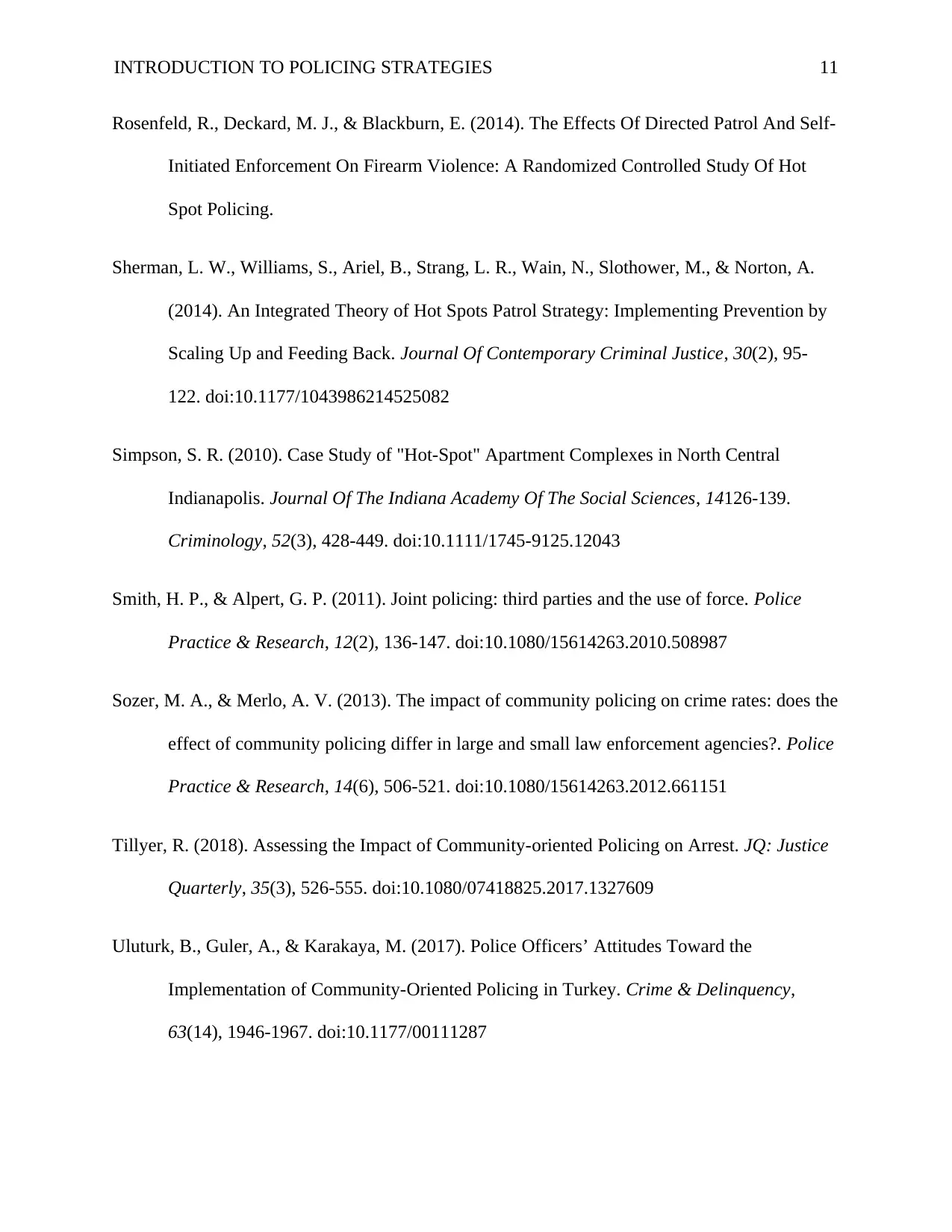
INTRODUCTION TO POLICING STRATEGIES 11
Rosenfeld, R., Deckard, M. J., & Blackburn, E. (2014). The Effects Of Directed Patrol And Self-
Initiated Enforcement On Firearm Violence: A Randomized Controlled Study Of Hot
Spot Policing.
Sherman, L. W., Williams, S., Ariel, B., Strang, L. R., Wain, N., Slothower, M., & Norton, A.
(2014). An Integrated Theory of Hot Spots Patrol Strategy: Implementing Prevention by
Scaling Up and Feeding Back. Journal Of Contemporary Criminal Justice, 30(2), 95-
122. doi:10.1177/1043986214525082
Simpson, S. R. (2010). Case Study of "Hot-Spot" Apartment Complexes in North Central
Indianapolis. Journal Of The Indiana Academy Of The Social Sciences, 14126-139.
Criminology, 52(3), 428-449. doi:10.1111/1745-9125.12043
Smith, H. P., & Alpert, G. P. (2011). Joint policing: third parties and the use of force. Police
Practice & Research, 12(2), 136-147. doi:10.1080/15614263.2010.508987
Sozer, M. A., & Merlo, A. V. (2013). The impact of community policing on crime rates: does the
effect of community policing differ in large and small law enforcement agencies?. Police
Practice & Research, 14(6), 506-521. doi:10.1080/15614263.2012.661151
Tillyer, R. (2018). Assessing the Impact of Community-oriented Policing on Arrest. JQ: Justice
Quarterly, 35(3), 526-555. doi:10.1080/07418825.2017.1327609
Uluturk, B., Guler, A., & Karakaya, M. (2017). Police Officers’ Attitudes Toward the
Implementation of Community-Oriented Policing in Turkey. Crime & Delinquency,
63(14), 1946-1967. doi:10.1177/00111287
Rosenfeld, R., Deckard, M. J., & Blackburn, E. (2014). The Effects Of Directed Patrol And Self-
Initiated Enforcement On Firearm Violence: A Randomized Controlled Study Of Hot
Spot Policing.
Sherman, L. W., Williams, S., Ariel, B., Strang, L. R., Wain, N., Slothower, M., & Norton, A.
(2014). An Integrated Theory of Hot Spots Patrol Strategy: Implementing Prevention by
Scaling Up and Feeding Back. Journal Of Contemporary Criminal Justice, 30(2), 95-
122. doi:10.1177/1043986214525082
Simpson, S. R. (2010). Case Study of "Hot-Spot" Apartment Complexes in North Central
Indianapolis. Journal Of The Indiana Academy Of The Social Sciences, 14126-139.
Criminology, 52(3), 428-449. doi:10.1111/1745-9125.12043
Smith, H. P., & Alpert, G. P. (2011). Joint policing: third parties and the use of force. Police
Practice & Research, 12(2), 136-147. doi:10.1080/15614263.2010.508987
Sozer, M. A., & Merlo, A. V. (2013). The impact of community policing on crime rates: does the
effect of community policing differ in large and small law enforcement agencies?. Police
Practice & Research, 14(6), 506-521. doi:10.1080/15614263.2012.661151
Tillyer, R. (2018). Assessing the Impact of Community-oriented Policing on Arrest. JQ: Justice
Quarterly, 35(3), 526-555. doi:10.1080/07418825.2017.1327609
Uluturk, B., Guler, A., & Karakaya, M. (2017). Police Officers’ Attitudes Toward the
Implementation of Community-Oriented Policing in Turkey. Crime & Delinquency,
63(14), 1946-1967. doi:10.1177/00111287

INTRODUCTION TO POLICING STRATEGIES 12
Webster, J. (2015). Effective third-party policing partnerships or missed opportunities? Policing
& Society, 25(1), 97-114. doi:10.1080/10439463.2013.817994
Webster, J. (2015). Effective third-party policing partnerships or missed opportunities? Policing
& Society, 25(1), 97-114. doi:10.1080/10439463.2013.817994
⊘ This is a preview!⊘
Do you want full access?
Subscribe today to unlock all pages.

Trusted by 1+ million students worldwide
1 out of 12
Your All-in-One AI-Powered Toolkit for Academic Success.
+13062052269
info@desklib.com
Available 24*7 on WhatsApp / Email
![[object Object]](/_next/static/media/star-bottom.7253800d.svg)
Unlock your academic potential
Copyright © 2020–2025 A2Z Services. All Rights Reserved. Developed and managed by ZUCOL.
